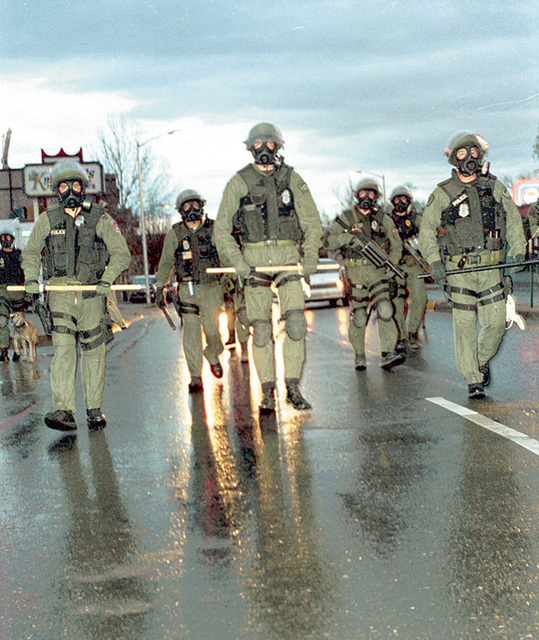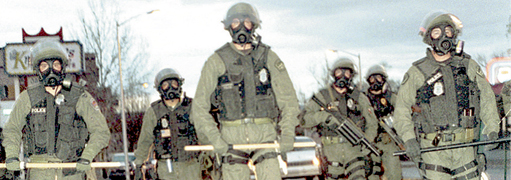It was a demonstration that went down as one of the biggest clashes between civilians and police in Albuquerque’s recent history. Hundreds gathered on March 20, 2003, to protest the invasion of Iraq. But things grew ugly that night in the University Area. From the Alibi’s 2003 report by Adam Brown and then News Editor Tim McGivern: "For 90 minutes Thursday night tensions grew between approximately 600 protesters—children in strollers, families, teens, adults of all stripes—and at least 100 police officers, some armed with automatic weapons, batons, and unidentifiable in their gas masks. "Then, with the whoosh and crackle, burning gas canisters [were] lobbed into the crowd and the pops of pepper balls fired in all directions. Chaos ensued as some protesters lobbed the gas canisters back at police while others ran coughing, tears streaming down their faces, from the scene. The vile smell of CS gas carried in the wind for three blocks as the vapors clung to the air over the Kevlar helmets of police in the intersection of Central and Cornell."Seven years later, 11 protesters are having their day in court. The defendants include the officials of the time: Mayor Martin Chavez, Department of Public Safety Chief Nick Bakas, Chief of Police Gilbert Gallegos and Capt. John Gonzales, among others. The plaintiffs, all demonstrators from that day, say their civil and constitutional rights were violated. The trial began Monday, Feb. 22. After a long day of jury selection, attorneys made their opening statements. Lawyer Cammie Nichols, arguing on behalf of the protesters, set the scene. Capt. Gonzales had been policing protests for months, she said, and he knew this one was coming. At USS Bullhead Memorial Park in the Southeast Heights, he gathered his troops: emergency response officers, SWAT, the bomb squad, motorcycle officers and horse-mounted patrols. The rally began peacefully, Nichols said, with demonstrators walking back and forth between the UNM Bookstore and the Frontier, obeying traffic signals. Gonzales ordered Central blocked off between Girard and University. Since the demonstrators had no audience, she said, they began to walk west. At University, marchers met a blockade of officers, she said. The demonstrators were ordered north along University and then west to Cedar. Eventually, the protest was turned back toward its point of origin at UNM. Pro-war demonstrators gathered along Central and shouted insults, according to the complaint, but "none of them were arrested or charged with any crime."Officers shot a protester with a beanbag round, the complaint states, and used batons and horses to force people to move. Nichols said a flashbang, a nonlethal stun grenade, caused panic. (The defendants’ attorneys argue this was actually a device thrown at police by protesters.) She added that protesters thought the beanbag guns were real guns aimed into the crowd. The complaint alleges none of the officers had identification markers—numbers or names—on their riot gear, which included helmets and face masks. That point was also raised by plaintiff Dr. John Fogarty in a late 2008 trial ["Protester Loses Civil Rights Fight," Dec. 18-24, 2008]. Fogarty couldn’t tell who’d arrested him, he testified. He said he’d been dragged into the street, exposed to tear gas and put in a wrist lock-hold that tore tendons. "They put cuffs on me," he said then. "They never read me any rights. They never charged me with anything. They never took me to the booking station. I wasn’t given any paperwork." Fogarty didn’t win his excessive force case. This new case looks to make First Amendment claims. Peter Simonson, executive director of the American Civil Liberties Union of New Mexico, said the plaintiffs will explain "how their First Amendment rights to free speech were violated by the defendant police officers in retaliation for their participation in a lawful and peaceful demonstration against our country’s military actions in Iraq." Among the principles at stake, he added, is the idea that citizens should be allowed to protest without being intimidated into silence because "government officials might not agree with the content of their speech." City Attorney Kathryn Levy opened by saying the Iraq War divided citizens everywhere, but that this case is not about the war. She said police officers take an oath to uphold the Constitution, and protesters have a constitutional right to speak their opinions peacefully. "With rights come responsibility," she said. Police are also obligated to protect the rights of business owners and other citizens, she added. The demonstration began peacefully, she said, but the tenor of the crowd shifted that day. "Any action was a response, a trained response," she said. "Police actions did not happen in a vacuum."The plaintiffs violated the law and invited a response from police they didn’t like, said lawyer Luis Robles. "The plaintiffs caused their own injuries," he said. Demonstrators didn’t ask the city for a parade permit, he pointed out. He showed images of protesters wearing ski masks and said, "They don’t seem peaceful. Why are they covering their identities?" He zoomed in on an anarchy symbol. There were families in the crowd that day, he acknowledged, but there was also a hardcore group of committed anarchists opposed to all laws and regulations. Their purpose, he said, was to push the activists in a non-peaceful direction. The crowd’s demeanor was far angrier, he added, than anything the Albuquerque Police Department had experienced before.The protesters were advancing on the police, Robles said, not the other way around. He told the story of a professor who approached an officer to tell him there were children in the crowd so the police shouldn’t fire tear gas canisters. The professor refused to stop moving forward when the officer told him to, Robles narrated, and even went so far as to grab the policeman’s baton. "The protest turned someone like a professor into someone who was willing to disarm a police officer," he said. Police reacted the way they did because demonstrators were going to try and take I-25, Robles said. Nichols said in her opening remarks that was a rumor started by a couple of people in the crowd. After the opening statements, two pictures had been painted of that night seven years ago. In one, the protesters were the antagonists and APD responded to an unusually hostile crowd spurred into aggression by fervent anarchists. In another, peaceful demonstrators encountered combative officers in riot gear who overreacted and used force unnecessarily, stifling the free speech of citizens. Jurors will make the call in the weeks to come.
The trial is expected to last between two and three weeks. Stay tuned for updates.





